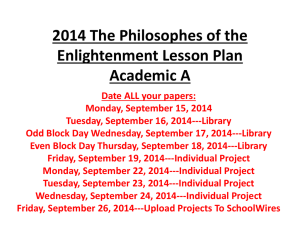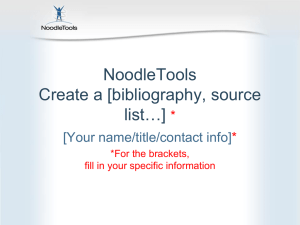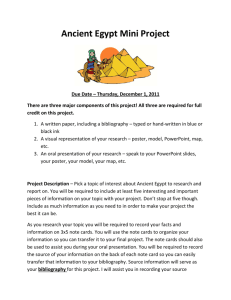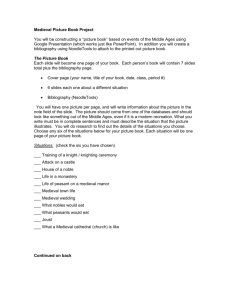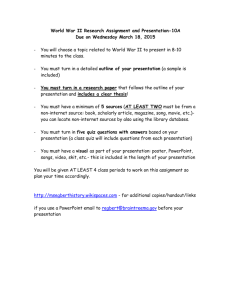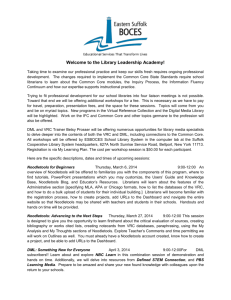Day One
advertisement
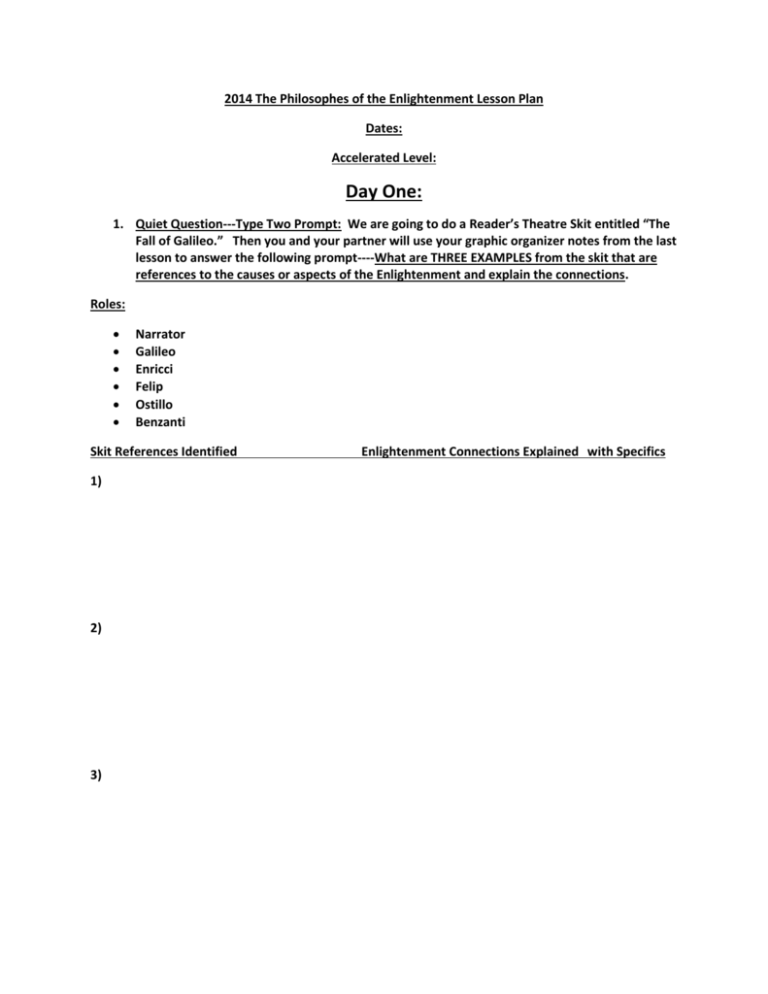
2014 The Philosophes of the Enlightenment Lesson Plan Dates: Accelerated Level: Day One: 1. Quiet Question---Type Two Prompt: We are going to do a Reader’s Theatre Skit entitled “The Fall of Galileo.” Then you and your partner will use your graphic organizer notes from the last lesson to answer the following prompt----What are THREE EXAMPLES from the skit that are references to the causes or aspects of the Enlightenment and explain the connections. Roles: Narrator Galileo Enricci Felip Ostillo Benzanti Skit References Identified 1) 2) 3) Enlightenment Connections Explained with Specifics 2. Class: We are going to watch a short film clip from United Streaming that reviews the concepts and a few examples of philosophes. It runs for about 3:22 minutes. 3. Individual: Common Formative Assessment---We will now begin a project that will focus on research, note-taking, bibliography, and parenthetical citing skills. You will learn how to use the program NoodleTools that is required for all the research projects and papers in the high school. You will be assigned one of the following philosophes to research and create a PowerPoint presentation on to teach your classmates. The PowerPoints will be uploaded on the SchoolWire’s teacher page, and your classmates will be viewing and taking notes for their graphic organizer from the PowerPoints. Handouts: Handout on how to use NoodleTools Handout on how to do parenthetical citations Handout on how to upload to SchoolWires Pink Grade Sheet Assigned Philosophes: 1) 2) 3) 4) 5) 6) 7) 8) 9) 10) 11) 12) 13) 14) 15) Thomas Hobbes---Focus on views on man and government John Locke---Focus on views on man, government, social contract, and natural rights Voltaire----Focus on views on man, government, and natural rights Jean Jacques Rousseau---Focus on views on man, government, social contract, and general will Baron de Montesquieu---Focus on views on man, government, and natural rights Baruch Spinoza---Focus on views on man and religion Hugo Grotius---Focus on natural laws, international law, and government Mary Wollstonecraft---Focus on views on man, concept of equality, and natural rights Cesare Beccaria---Focus on government and system of crime and punishment Adam Smith---Focus on laissez-faire capitalism, three laws, and role of government Mary Astell---Focus on views on man, concept of equality, and natural rights Olympe de Gouges---Focus on views of man, concept of equality, and natural rights Thomas Paine---Focus on views of government, natural rights, and slavery Thomas Reid ---Focus on free will and common sense Marquise de Concordcet---Focus on government, equality, and progress Format: To be done in PowerPoint format----white background and black font, use Calibri font Bulleted format Must have a minimum of FIVE different visuals within the PowerPoint o Image of philosophe o Symbol or book cover explained in context o THREE other visuals---choice of maps, political cartoons, or other visual references Must have a bibliography from NoodleTools on cut and pasted into the last slide Must have parenthetical citations on each slide to document where the information came from in your research An example one has been created and uploaded to the teacher page. Slide Topics: A. Title Slide----Philosophe name with image of him/her---1 slide B. Biography Slides----2 to 3 slides C. Main Ideas and Books/Essays (Works)---total of 4 to 6 slides a. 3 slides on Main Ideas explained b. 3 slides on Main Works explained D. TWO Primary Source Quotes with Explanation---2 to 4 slides E. Obstacles/Adversaries---2 to 3 slides F. Impact/Influence----on native country, continent, world---2 to 3 slides G. Symbol----unique title page of book or image that really represents ideas---1 to 2 slides H. Bibliography with a minimum of FOUR different sources---1 slide I. Total of 17-23 slides Resources to Use: 1) ABC-CLIO: World History The Modern Era (Library database) http://www.gvsd.org/Page/4701 (If needed – USERNAME: greatvalley PASSWORD: library) 2) Modern History Internet Sourcebook---Enlightenment and American Revolution: http://www.fordham.edu/halsall/mod/modsbook.asp 3) Spartacus Educational---British History: http://www.spartacus.schoolnet.co.uk/ 4) Internet Encyclopedia of Philosophy: http://www.iep.utm.edu/ 5) Stanford Encyclopedia of Philosophy: http://plato.stanford.edu/ 6) Luminarium Anthology of English Literature----17th Century and Restoration: http://www.luminarium.org/ 7) Wikimedia Commons: commons.wikimedia.org Days Two through Eight: Chunking: Library/Research Day One: Instruction on how to use NoodleTools and set up bibliography. Go to TWO different websites and copy and paste the information into separate Word documents. Put sources into NoodleTools. Homework: Highlight and make notes on the information you found and copied into the Word documents labeling what slides the different information would go into. Library/Research Day Two: Go to TWO more different websites and copy and paste the information into separate Word documents. Put sources into NoodleTools. Homework: Highlight and make notes on the information you found and copied into the Word documents labeling what slides the different information would go into. Library/Research Day Three: Finish last of research for historical content and copy and paste the information into separate Word documents. Research WikiImages for your required visuals for the PowerPoint. Put sources into NoodleTools. Homework: Highlight and make notes on the information you found and copied into the Word documents labeling what slides the different information would go into. Creation of PowerPoint Work Day One: Complete Title Slide. Complete Biography Slides. Begin Main Ideas and Works Slides. Homework: Finish Main Ideas and Works Slides. Creation of PowerPoint Work Day Two: Complete Primary Sources and Explanation Slides. Complete Impact/Influence Slides. Complete Symbol Slides. Homework: Completed Obstacles /Adversaries Slides and add all required visuals to slides. Creation of PowerPoint Work Day Three: Complete Bibliography Slides. Peer Editing Conference---You will be matched up to edit each other’s work. Homework: Make all final revisions to slides. Completion of PowerPoint and Upload Work Day Four: Upload PowerPoint to SchoolWires at the start of class---NO CLASS TIME TO WORK ON IT! Class time to begin to visit your classmates’ PowerPoints and take notes in the provided graphic organizer filling it in. o You should visit at least TWO today in class. Homework: For the next week and a half, your homework will be to visit the other PowerPoints created by your classmates and take notes in the provided graphic organizer filling it in. o You should do one to two a night to get done in time. o You need these notes for the culminating assessments.
